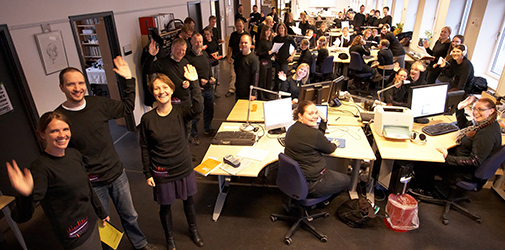Spoken language is a dynamic entity
During the past century, Denmark has evolved from being a traditional multi-dialectal society to probably the most homogeneous linguistic community in Europe. Almost all young Danes, from Skagen to Svaneke, now speak a version of the language that is closer to Copenhagen Danish than to the local traditional dialects. Basically, only prosodic differences remain between dialects, i.e. variations in intonation, glottal stop and syllable stress.

Team photo
From 2005 to 2015, a team of researchers under the auspices of the Danish National Research Foundation Centre for Language Change in Real Time (LANCHART) at the University of Copenhagen studied dialectal change, recording and analysing spoken Danish and making their research available to the public – and to future generations. During the ten year period, LANCHART was directed by Professor Frans Gregersen and was funded by the Danish National Research Foundation. Presently, the centre continues as an integrated part of Department of Nordic Research under the joint leadership of Associate Professors Marie Maegaard and Torben Juel Jensen.
The researchers carried out one of the world’s first major ‘panel studies’ by studying the language spoken by the same informants over a prolonged period of time. The informants were from different locations around Denmark: Vinderup, by the Limfjord in the north of Jutland; Odder, south of Aarhus; Vissenbjerg on the island of Funen; and from Copenhagen, Køge and Næstved on Zealand. New recordings were made and compared with earlier ones (sometimes up to 40 years old) of the same people, allowing the team to expand our knowledge of how dialects and spoken language in general change.
For example, we now know that not only are there differences in spoken language between generations but that individuals change the way they speak throughout their lives. Similarly, we have become aware that not only does the Danish language vary from place to place – albeit much less so than in the past – but also that new variations emerge along with new social identities, for example within different youth sub-cultures.
Transcripts of the audio recordings are used to analyse the spoken language. Linking transcripts to the audio files makes it possible to search and encode the material according to particular linguistic features, e.g. the pronunciation of a particular word, grammatical variations or differences in the word order in sentences; i.e. the method makes it possible to conduct systematic analyses of spoken language.
Impact
The main product of LANCHART’s work is the so-called corpus: a collection of spoken Danish from different parts of the country, generations and social backgrounds, which researchers in an untold future will continue to develop at the centre. On the basis of this rich collection of processed data, the researchers have generated a range of practical materials for use in further research and education at all levels, from primary and secondary school to university level.
SNAK (SPEAK) consists of seven online games users can play to explore contemporary spoken language. SNAK was developed by LANCHART researchers in collaboration with Serious Games Interactive.
In the Ordbog over dansk talesprog (Dictionary of Spoken Danish) you can look up interjections and find information about the pronunciation, form and function of words.
LANCHART offers a range of teaching materials, including quizzes, language tests, and other serious as well as humorous linguistic material. Visitors to the site can also ask staff and researchers at LANCHART questions.
Bestil en foredragsholder (Book a speaker) is a service for upper-secondary schools, teacher-training colleges and other institutions who would like a talk on language change, young people and language, dialects or other subjects related to LANCHART’s research. The centre’s researchers may be booked to institutions to talk about their field of interest, and teachers and classes are also welcome to visit the Centre.
Further info
Danish National Research Foundation
Centre for Language Change in Real Time (LANCHART)
The book Hvad ved vi nu – om danske talesprog?
(What do we know now – about Danish spoken language?) Edited by Professor Frans Gregersen and Professor Tore Kristiansen, published by LANCHART
Contact
Frans Gregersen
Professor, Department of Nordic Studies and Linguistics
E-mail: fg@hum.ku.dk
Tel.: +45 27 51 64 35
Marie Maegaard
Associate Professor, Department of Nordic Research
E-mail: mamae@hum.ku.dk
Tel.: +45 51 92 68 04
Torben Juel Jensen
Associate Professor, Department of Nordic Studies
and Linguistics
E-mail: tjuelj@hum.ku.dk
Tel.: +45 35 32 84 95
Tore Kristiansen
Professor, Department of Nordic Research
E-mail: tk@hum.ku.dk
Tel.: +45 35 32 85 11
